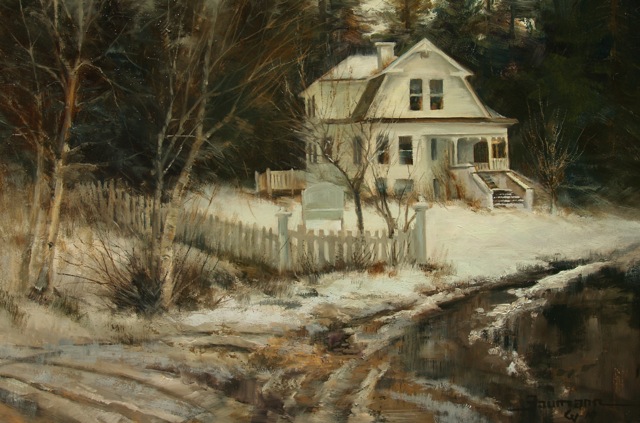“Grand Old Lady” by Stefan Baumann
At the end of April, we had a sudden winter snowstorm. The late snow offered two more opportunities to paint the effects of melting snow on the ground. This painting of the Mount Shasta Inn is one of those paintings. On my way to the art class that I teach in Mount Shasta, a warm
light on an old farmhouse contrasted with the coldness of the melting snow caught my eye and I could not wait to paint it. After class, I returned to the house and painted this “Grand Old Lady” as my last winter painting of the season.
The underlying goal of creating a good composition when you paint is to attract the viewer’s attention. Everything is placed in the painting to direct the viewer deeper into the painting and draw his attention to the focal point, where the desire to linger is encouraged by the brightest light or darkest values.
Since art is essentially self-expression, personal preference is fundamental. Many of the elements of composition rely on the simple matter of personal taste and interpretation, making art a spontaneous creative process that begs to happen without rules. However, many artists want to have a predictable approach to create attractive paintings and often hope to find a step-by-step method that they can use (similar to recipes that help with cooking or knitting). Having some guidelines in mind before beginning to paint helps the artist develop an eye-catching composition that increases the possibility of success.
Here are some suggestions for composing a good painting.
First, ask yourself, “What about this subject inspires me so much that I want to paint it?” Answering this question will help you compose a painting that includes elements that interest you and captures your attention to share with the viewer.
Second – Keep it simple. When in doubt, simplify it. Ask yourself, “What can I leave out” instead of “what can I put into the painting?” A painting that is simple and directs the viewer to the center of interest will transfer the excitement you felt when you chose the subject. It is especially important to keep it simple when you paint the side portions of your canvas so the focal point is clearly visible.
Third – Create Harmony. View the subject and ask yourself “What overall unifying device unites the painting?” It can be a single light source, or the mood of the atmosphere, or colors that work together that create great unifying effects. When using color, look for color-related areas such as trees, grass, water and sky and notice how they all work together to create a sense of harmony. Nature is always harmonious if you learn to paint what you see. Painting the way we think things are frequently leads to complications.
Remember, a good composition is one where the viewer is unaware the artist has purposely composed the painting. There is no limit to the possible arrangements of compositional objects within a painting. I highly recommend that you take risks. Always look for a different way of seeing a subject. Try something new. After all, no one ever got a gold medal for a perfect swan dive off a low diving board. It is exciting to paint from your own sense of what is desirable and appealing. I have to say that my most successful compositions were ones that I painted intuitively from my gut and had the most fun painting.
___________________________________________
Plein air and Alla Prima artist Stefan Baumann, host of the PBS painting series “The Grand View, America’s National Park through the eyes of an artist” and author of “Observations Of Art and Nature,” travels in his vintage travel trailer painting America’s western landscape. Baumann paints outdoors with oils and canvas capturing stunning vistas, wildlife, western landscapes, National Parks and still life, thrilling art collectors throughout the world. He has many collectors acquiring his paintings as investment internationally. His painting style is called Romantic Realism with Lumunism and the extraordinary way he captures the effect of light is a truly an American Style used to paint the Western Landscape. He can be seen painting in Yellowstone, Yosemite and in the Grand Canyon and Baumann’s “how to paint” DVDs filmed on location in the National Parks are the very best on the market.

